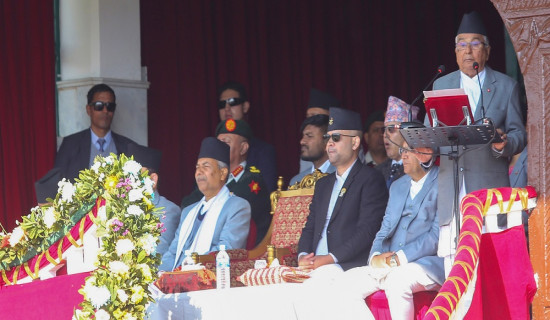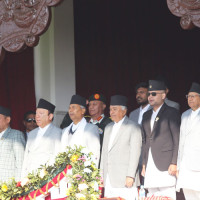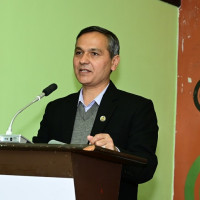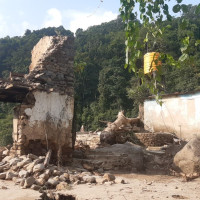- Monday, 15 December 2025
58thAnniversary Special Supplement
News Media At The Crossroads
Scores of daily papers have folded up in the past three decades. Among the earliest and longest-lasting daily mastheads, Samaj, The Commoner and the Motherland closed shop years ago. In addition to the Gorkhapatra and The Rising Nepal, there were at least a dozen daily papers in the private sector that circulated as leading publications in their category when multiparty polity was restored in the spring of 1990.
While the government-owned Gorkhapatra and The Rising Nepal continued as the country’s oldest existing national dailies, the others were of barely tabloid size and had all quit publishing by the turn of the new millennium.
It was actually the private sector weeklies that ruled the roost since their pioneer peers debuted in the 1950s. In fact, the first private newspaper was the weekly Jagaran, which was launched on the same day in 1951, heralding the dawn of democracy in the country.
In the 1990s, big improvements occurred. The broadsheets from the private sector made their mark not only in Kathmandu Valley but also in several cities elsewhere. Legal provisions for ensuring that newspaper registrations would not be scrapped for the content they carried attracted business houses to venture into the media.
Welcome surge: Scores of all-colour newspapers and magazines became a familiar face of the print landscape. Daily papers became regular in dozens of towns outside Kathmandu. The late 1990s recorded private radio stations that aired news bulletins—something that has yet to happen in not only the rest of South Asia but in most other countries, including many listed as “the most advanced” economically and in terms of free press. Of the nearly 900 radio stations in regular operation, In Nepal, most boast news services. TV channels broadcasting news are also part of the new normal.
However, the existing picture does not denote that all is hunky-dory. The fine print between the lines is something deeply disturbing. More than 25 years after the Working Journalists’ Act was announced, the salaries and allowances fixed by the government-appointed minimum wage fixation committee are yet to be fully implemented. Even larger media groups have found ways to dodge paying the minimum wage on time, which is barely what a helper or office assistant in a civil or government corporation collects.
One has only to scratch the surface for things beneath and the obvious. An honest in-house review followed by meeting at least the bare minimum investment by way of infrastructure, competent human resources, and energetic doers at the leadership in the quest for contents with topics and angles.
Without reinventing approaches to the prevailing environs, the news media will have mammoth challenges for mere survival, let alone boosting the prospects of increasing their advertising revenue. Moreover, the weak advertising base in a country whose state of industrial station needs no elaboration.
Pre-requisites: Media organisations should shed complacency and indifference when they face the choice of either shaping up or shipping out. There is no midway point at a time when people are flooded with multiple avenues of information and entertainment. Audiences are prone to probing and migrating from news services to other forms of media.
Credibility is the soul of the image and reputation of durable kind for any sector, especially for those disseminating news. This is earned not by faithfully dishing out facts but much more. Transparent impartiality, newsworthy contents, and a fair representation of current issues that audiences want or would be excited about constitute the master keys to audience respect and loyalty.
In-depth reports on major events, interpretative pieces offering an all-rounded perspective, and a constant search for investigative stories break off the beaten track with refreshing coverage that whets public interest for more. They provide an insight into major current events and developments, thus enabling the listening, viewing, and reading audiences to draw conclusions and make decisions on their own.
The times have changed. So has the technology advanced to levels confined, at best, only to imagination before the onset of the 1990s. Crude assumptions as to who might be the potential audience and what might be their keen interest cannot provide an accurate answer. Lack of audience surveys on all categories of news outlets constitutes the crux of the problem.
It was coming: In a brief encounter with the chairman of one of the biggest and most powerful news media organisations six years ago at the book launch of veteran journalist Kishore Nepal, I candidly told him without mincing words: “The news media, including yours, are in for a grave situation. Your paper’s sales will dip steeply within five years. So will the revenue collection, as a result.”
Whether the tycoon feigned a troubled mind or his smugness vanished for fleeting seconds, he pressed: “I need to talk to you tomorrow or the day after.” I asked him to give me a call some days later. He never did; either he did not feel the need to or he did not summon the energy to hear me out. Unfortunately, his print service has suffered serious setbacks.
Stories should be more than factual; the content carrying newsworthiness should be vetted by proper gatekeeping. Toxic polarisation and denial inflict deep damage on news outlets. Should the condition get overstretched, the decline hurtles beyond salvage.
Earlier this month, the Ncell telecom share sales scandal stirred sensational stories in the Nepalese media. The company was quick to book front-page advertising space in some media to explain its professional commitment. Most major media outlets were reticent about investigating the story, as they relied basically on official briefings, which, too, were relegated to the business page.
Concrete claim: News outlets bent on developing a truly all-embracing character would inflict self-wound if front-page items almost invariably originated in Kathmandu Valley and foreign sites. If a front-page item occasionally carries a dateline outside the premier valley, it could very well be a VVIP visit or the occurrence of some disaster.
Opinion write-ups should reflect at least a modicum of diversity in topics reflecting ground reality. An ideological split should not convert a news outlet to serving partisan interests and biassed views that prevent the creation of a truly reliable public platform echoing and mirroring society.
It is high time that serious efforts were made to decode what went wrong so swiftly with so many “big” organisations in such a short span of time. That many large groups are widely believed to be not paying salaries to staff members for three or more months presents a pathetic prospect for not only concerned employees but also wannabe journalists.
The wake-up call is also for a more comprehensive Press Council Act that revamps the media watchdog, does more to discourage the politicisation of professional media associations, and upholds a transparent mechanism for issuing state subsidies in deference to quality and not charity or undue patronage.
To stem uncertain drifts and declines, the option would be to take a deeper plunge into the managerial and investment sides together with the editorial department, led by people possessing proactive imagination and drive to deliver. Surely, there must, in some corners, be the strength to steer the course better and richer in content and service. That is, if the management is willing.
(Kharel is a senior journalist, media educator and former Editor-in-Chief of The Rising Nepal.)
















